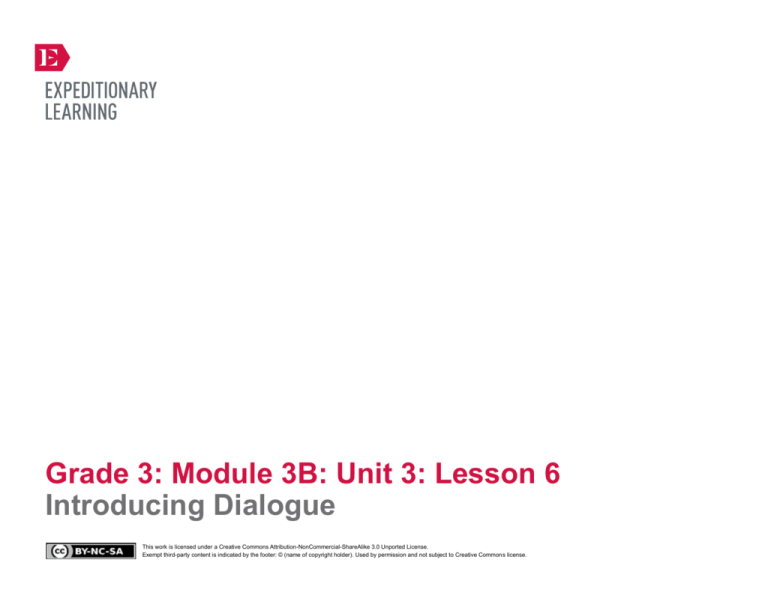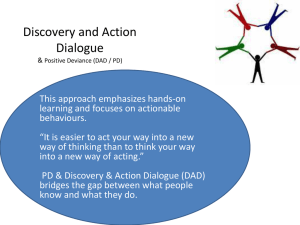
Grade 3: Module 3B: Unit 3: Lesson 6
Introducing Dialogue
This work is licensed under a Creative Commons Attribution-NonCommercial-ShareAlike 3.0 Unported License.
Exempt third-party content is indicated by the footer: © (name of copyright holder). Used by permission and not subject to Creative Commons license.
GRADE 3: MODULE 3B: UNIT 3: LESSON 6
Introducing Dialogue
Long-Term Targets Addressed (Based on NYSP12 ELA CCLS)
I can craft narrative texts about real or imagined experiences or events. (W.3.3)
a. I can use dialogue to show the actions, thoughts, and feelings of my characters.
Supporting Learning Target
Ongoing Assessment
• I can use just enough dialogue to explain events in a narrative more clearly.
• Wolf Narrative excerpt for dialogue
Created by Expeditionary Learning, on behalf of Public Consulting Group, Inc.
© Public Consulting Group, Inc., with a perpetual license granted to Expeditionary Learning Outward Bound, Inc.
NYS Common Core ELA Curriculum • G3:M3B:U3:L6 • June 2014 • 1
GRADE 3: MODULE 3B: UNIT 3: LESSON 6
Introducing Dialogue
Agenda
Teaching Notes
1. Opening
• To give you time to provide feedback on student narrative plans and to address standard W.3.3a, in this
lesson students pause to analyze the dialogue in the Wolf Narrative model, generate criteria for using
dialogue in a narrative, and then use the criteria to rewrite an excerpt of the Wolf Narrative model to
include dialogue.
A. Unpacking Learning Targets (5 minutes)
2. Work Time
A. Analyzing Dialogue in the Wolf Narrative Model and
Dialogue Mini Lesson (15 minutes)
B. Writing Dialogue into a Narrative (25 minutes)
3. Closing and Assessment
A. Whole Group Critique and Revision (15 minutes)
4. Homework
A. Revise the dialogue examples to achieve the criteria
listed at the top of the page.
B. Continue reading your independent reading book.
• It is important to emphasize in this lesson that although the narrative is about real wolves, it is a fiction
narrative. To understand why the characters are behaving as they are so that the narrative makes sense,
we have to be creative, as we were when choosing character traits for the main wolf character. This
involves using dialogue as though the wolves are speaking to each other.
• To ensure the dialogue students include is meaningful and doesn’t weaken the plot of the narrative,
students are given a specific purpose for the dialogue.
• In the Closing of this lesson, the group critiques a piece of student work for practice. This process needs
to be carried out carefully to ensure the pair of students being critiqued feel validated and respected.
Students involved in the critique should be willingly volunteers, knowing what will be expected of them.
During the process, ensure that students use the criteria generated earlier in the lesson as a basis for
their critique, and provide suggestions for improvement based on those criteria. If you feel your
students will have difficulty with this, substitute a teacher-written piece for critique instead of a student
piece.
• In preparation for including dialogue in their own narratives, students have further practice with
applying the criteria to excerpts of text for homework.
• In advance:
– Consider which pairs would benefit from and respond well to a group critique, and ask them if they
would like to do it.
– Post: Criteria of a Strong Narrative anchor chart; learning target.
Created by Expeditionary Learning, on behalf of Public Consulting Group, Inc.
© Public Consulting Group, Inc., with a perpetual license granted to Expeditionary Learning Outward Bound, Inc.
NYS Common Core ELA Curriculum • G3:M3B:U3:L6 • June 2014 • 2
GRADE 3: MODULE 3B: UNIT 3: LESSON 6
Introducing Dialogue
Lesson Vocabulary
Materials
dialogue
• Narrative Writing Rubric (from Lesson 1; one per student and one to display)
• Wolf Narrative model (from Unit 2, Lesson 1; one per student and one to display)
• Highlighters (one per student)
• Dialogue examples (one for display)
• Criteria of a Strong Narrative anchor chart (begun in Lesson 1)
• Wolf Narrative excerpt for dialogue (one per student and one to display)
• Dialogue homework (one per student)
Opening
Meeting Students’ Needs
A. Unpacking Learning Targets (5 minutes)
• Direct students’ attention to the posted learning target and read it aloud:
• Posting learning targets allows
students to reference them
throughout the lesson to check their
understanding. The learning targets
also provide a reminder to students
and teachers about the intended
learning behind a given lesson or
activity.
* “I can use just enough dialogue to explain events in a narrative more clearly.”
• Ask students to discuss with an elbow partner:
* “What is dialogue? What does it look like in a narrative?”
• Select volunteers to share their responses. Listen for students to explain that dialogue is any spoken word in a narrative and
that it has quotation marks around it.
• Invite students to retrieve their Narrative Writing Rubrics (from Lesson 1) and display a copy.
• Focus students’ attention on W.3.3b, “I can use dialogue and descriptions to show the actions, thoughts, and feelings of my
characters.”
• Explain that students are going to use dialogue in their narratives to show the thoughts and feelings of their characters and
to advance the action in the narrative.
Created by Expeditionary Learning, on behalf of Public Consulting Group, Inc.
© Public Consulting Group, Inc., with a perpetual license granted to Expeditionary Learning Outward Bound, Inc.
NYS Common Core ELA Curriculum • G3:M3B:U3:L6 • June 2014 • 3
GRADE 3: MODULE 3B: UNIT 3: LESSON 6
Introducing Dialogue
Work Time
Meeting Students’ Needs
A. Analyzing Dialogue in the Wolf Narrative Model and Dialogue Mini Lesson (15 minutes)
• Pair students up.
• Analyzing a model can provide
students with an example of how
their work should look.
• Ask them to discuss with their partners:
* “Writing dialogue in narratives can be challenging. So how can we learn how to use dialogue in our narratives? Where can
we find good examples?”
• Cold call students to share their responses. Listen for students to explain that they can find good examples in existing
narratives, so a good way to learn more about the use of dialogue would be to analyze the dialogue in narratives.
• Invite students to retrieve their Wolf Narrative model and display a copy.
• Invite students to look at the first paragraph. Read it aloud as students follow along silently.
• Ask students to discuss in pairs:
* “Remember that dialogue is a conversation between two or more characters. Is there any dialogue in this paragraph? How
do you know?”
• Select volunteers to share their responses. Listen for students to explain that Lightning speaks in the first paragraph.
• Ask students to discuss in pairs:
* “How do we know Lightning is speaking? What clues does the text give us?”
• Ask for volunteers to share their responses with the whole group. Listen for students to explain that we know Lightning is
going to speak because the text says, “… and solemnly addressed the rest of the pack” and because what it says after that is
written in quotation marks.
• Distribute highlighters.
• Tell students that they are going to reread the rest of the narrative with their partners looking for dialogue, and when they
find it they are going to highlight it.
• Point out to students that they may also find a character’s feelings in quotation marks, so they will need to read the text
carefully to determine whether it is a conversation between two or more people or whether it is a characters thoughts.
• Circulate to support students as they analyze the text. Ask students guiding questions:
* “Why have you highlighted that? How do you know it is dialogue?”
Created by Expeditionary Learning, on behalf of Public Consulting Group, Inc.
© Public Consulting Group, Inc., with a perpetual license granted to Expeditionary Learning Outward Bound, Inc.
NYS Common Core ELA Curriculum • G3:M3B:U3:L6 • June 2014 • 4
GRADE 3: MODULE 3B: UNIT 3: LESSON 6
Introducing Dialogue
Meeting Students’ Needs
Work Time (continued)
* “Is there someone speaking?”
• As students begin to finish, refocus whole group.
• Ask volunteers to share any dialogue they found. Listen for students to explain that there is dialogue in the second paragraph
between Lightning and Little Foot, and there is also dialogue in Paragraph 6 between Black Ears and Lightning.
• Display the dialogue examples. Point out that the middle paragraph is the same as Paragraph 2 in the Wolf Narrative
model. Read the first two paragraphs aloud as students follow along silently.
• Ask students to discuss in pairs:
* “What is the difference between these two paragraphs?”
• Select students to share their responses. Listen for students to explain that there is no dialogue in the first paragraph, but
there is in the second.
• Ask students to discuss in pairs:
* “So after reading the paragraph with dialogue and without dialogue, why do you think the author has used dialogue here?
What does it do to the narrative?”
• Select students to share their responses. Listen for students to explain that the dialogue highlights Lightning as the alpha
male because he is the one who makes the plan, and it also clearly emphasizes how Little Foot is eager to help, but that
Lightning thinks he is too young and inexperienced.
• Now read the third paragraph aloud as students follow along silently.
• Ask students to discuss in pairs:
* “What are the differences between the second and third paragraphs?”
• Cold call students to share their responses. Listen for students to explain that there is more dialogue in the third paragraph.
• Ask students to discuss in pairs:
* “Which one tells this part of the narrative more clearly? Why?”
• Select students to share their responses. Listen for and guide students to understand that there is a lot of dialogue in the
third paragraph, which makes it more confusing and detracts from the real point of the narrative here, which is Lightning’s
plan to catch the deer. Emphasize that too much dialogue can be distracting sometimes, so it is important to find a balance.
The plot of the narrative needs to be clear throughout.
• Ask students to discuss in pairs:
Created by Expeditionary Learning, on behalf of Public Consulting Group, Inc.
© Public Consulting Group, Inc., with a perpetual license granted to Expeditionary Learning Outward Bound, Inc.
NYS Common Core ELA Curriculum • G3:M3B:U3:L6 • June 2014 • 5
GRADE 3: MODULE 3B: UNIT 3: LESSON 6
Introducing Dialogue
Meeting Students’ Needs
Work Time (continued)
* “So how do you write dialogue into a narrative? What do you notice about the way the dialogue is written?”
• Cold call students to share their responses. Listen for students to explain that the text usually sets up that someone is going
to talk, the speech is in quotation marks, there is a comma before the quotations marks, punctuation goes inside the
quotation marks, and dialogue said by a new character is written on new line.
• Focus students’ attention on the Criteria of a Strong Narrative anchor chart.
• Ensure that something like the following is recorded:
– Contain dialogue to make ideas clearer:
• Not too much dialogue or the narrative becomes too confusing.
• The text usually sets up that someone is going to talk; for example: Lightning said, “…”
• The speech is in quotation marks; for example: “Black Ears and I will distract the deer, causing them to run toward the
rest of you, who will be hiding out in the trees. Twins, as the deer come close, take one of them down from either side.”
• There is a comma before the quotations marks; for example: Lightning said, “Black ears and I …”
• Punctuation goes inside the quotation marks; for example: “What about me, Lightning? What am I going to do?”
• Dialogue said by a new character is written on a new line; for example:
• Lightning frowned before replying, “You will hide out in the trees until the twins have brought one of the deer to the
ground, at which point you will help finish the job.”
• “OK.” Little Foot was disappointed.
B. Writing Dialogue into a Narrative (25 minutes)
• Display and distribute the Wolf Narrative excerpt for dialogue.
• Invite students to whisper read the excerpt of the Wolf Narrative model recorded on the handout.
• Explain to students that there isn’t any dialogue in this paragraph, but there could be since this is quite a dramatic moment
when the wolves find Little Foot. Emphasize here that although the narrative is about real wolves, it is a fiction narrative. To
understand why the characters behave as they do so that the narrative makes sense, we have to be creative, as we were when
choosing character traits for the main wolf character. This involves using dialogue as though the wolves are speaking to each
other.
• Asking students to practice writing
dialogue without having to think
about writing the rest of the text
provides them with low stakes
practice and gives them confidence
to include dialogue in their own
writing.
• Read the directions with students.
Created by Expeditionary Learning, on behalf of Public Consulting Group, Inc.
© Public Consulting Group, Inc., with a perpetual license granted to Expeditionary Learning Outward Bound, Inc.
NYS Common Core ELA Curriculum • G3:M3B:U3:L6 • June 2014 • 6
GRADE 3: MODULE 3B: UNIT 3: LESSON 6
Introducing Dialogue
Meeting Students’ Needs
Work Time (continued)
• Focus their attention on the Criteria of a Strong Narrative anchor chart and the points about dialogue that have been listed.
• Remind students to use these points to help them craft dialogue for this paragraph.
• Ask students to begin working on this with their partners.
• Circulate to support students as they work. Ask guiding questions:
* “How does this dialogue show how the wolves feel about finding Little Foot?”
* “How does this dialogue show how Little Foot feels about being found?”
* “Is there too much dialogue in here? Or do you think the plot of the narrative is still clear?”
Closing and Assessment
Meeting Students’ Needs
A. Whole Group Critique and Revision (15 minutes)
• Select a volunteer pair that wants to share their rewritten excerpt with the rest of the group.
• A whole group critique can give all
students ideas about how to
improve their work.
• Ask this pair to come to the front of the group.
• Display their writing and invite the pair to read it aloud for the group.
• Refer the group to the criteria about dialogue recorded on the Criteria for a Strong Narrative anchor chart. Go through each
item on the list and ask students whether the volunteer pair has achieved the criteria in their rewritten excerpt and if not
how they could improve their work.
• Invite all pairs to revise their excerpt according to the whole group critique.
• Distribute dialogue homework.
Homework
Meeting Students’ Needs
• Revise the dialogue examples to achieve the criteria listed at the top of the page.
• Continue reading your independent reading book.
Created by Expeditionary Learning, on behalf of Public Consulting Group, Inc.
© Public Consulting Group, Inc., with a perpetual license granted to Expeditionary Learning Outward Bound, Inc.
NYS Common Core ELA Curriculum • G3:M3B:U3:L6 • June 2014 • 7
Grade 3: Module 3B: Unit 2: Lesson 6
Supporting Materials
This work is licensed under a Creative Commons Attribution-NonCommercial-ShareAlike 3.0 Unported License.
Exempt third-party content is indicated by the footer: © (name of copyright holder). Used by permission and not subject to Creative Commons license.
GRADE 3: MODULE 3B: UNIT 3: LESSON 6
Dialogue Examples
Example 1:
Leaving Bright Eyes to look after the pups, the pack headed out to hunt. After running for a mile or
more, Lightning spotted a couple of deer in a clearing in the trees. He stopped the pack and they made
a plan. Lightning and Black Ears would distract the deer, causing them to run toward Little Foot and
the twins, who would be hiding out in the trees until one of the deer was close enough to catch. While
Little Foot would help, as the older, more experienced hunters, the twins would do most of the work.
Example 2:
Leaving Bright Eyes to look after the pups, the pack headed out to hunt. After running through the
forest for a mile or more, Lightning spotted a couple of deer in a clearing. He stopped the pack and
they made a plan. Lightning said, “Black Ears and I will distract the deer, causing them to run toward
the rest of you, who will be hiding out in the trees. Twins, as the deer come close, take one of them
down from either side.”
Lightning didn’t mention Little Foot’s role in the plan, so Little Foot asked timidly, “What about
me, Lightning? What am I going to do?”
Lightning frowned before replying, “You will hide out in the trees until the twins have brought one
of the deer to the ground, at which point you will help finish the job.”
“OK.” Little Foot was disappointed. Once again, he would be out of the game until the last minute.
His small feet made him a very fast and quiet runner, but his lack of experience meant that the older
wolves didn’t trust him enough yet.
Copyright © 2013 by Expeditionary Learning, New York, NY. All Rights Reserved
NYS Common Core ELA Curriculum • G3:M3B:U3:L6 • June 2014 • 9
GRADE 3: MODULE 3B: UNIT 3: LESSON 6
Dialogue Examples
Example 3:
Leaving Bright Eyes to look after the pups, the pack headed out to hunt. After running through the
forest for a mile or more, Lightning spotted a couple of deer in a clearing. He stopped the pack and
they made a plan. Black Ears said, “What are we going to do, Lightning?”
“Black Ears and I will distract the deer, causing them to run toward the rest of you, who will be
hiding out in the trees. Twins, as the deer come close, take one of them down from either side.”
“You can count on us,” said the twins in unison. “We won’t let you down.”
“I know you won’t; I trust you both. You always work hard for our pack and help us to get food,”
replied Lightning.
Lightning didn’t mention Little Foot’s role in the plan, so Little Foot asked timidly, “What about
me, Lightning? What am I going to do?”
Lightning frowned before replying, “You will hide out in the trees until the twins have brought one
of the deer to the ground, at which point you will help finish the job.”
“OK.” Little Foot was disappointed. Once again, he would be out of the game until the last minute.
His small feet made him a very fast and quiet runner, but his lack of experience meant that the older
wolves didn’t trust him enough yet.
“It’s OK, Little Foot,” said Black Ears. “Your time will come.”
Copyright © 2013 by Expeditionary Learning, New York, NY. All Rights Reserved
NYS Common Core ELA Curriculum • G3:M3B:U3:L6 • June 2014 • 10
GRADE 3: MODULE 3B: UNIT 3: LESSON 6
Wolf Narrative Excerpt for Dialogue
Name:
Date:
Excerpt:
The pack had been searching for hours. Just as they were about to give up and head back to the
rendezvous site, one of the twins caught Little Foot’s scent on the air. He howled for the rest of the
pack who immediately raced to join him.
Little Foot heard the pack and replied, “I’m here. I’m here. I’m next to the clearing where we saw
the deer.”
The pack soon found him and Little Foot smiled at them weakly. Black Ears licked his nose
affectionately.
Directions: Rewrite this paragraph with dialogue to emphasize how the wolves felt about finding
Little Foot and how Little Foot felt about being found.
Copyright © 2013 by Expeditionary Learning, New York, NY. All Rights Reserved
NYS Common Core ELA Curriculum • G3:M3B:U3:L6 • June 2014 • 11
GRADE 3: MODULE 3B: UNIT 3: LESSON 6
Dialogue Homework
Name:
Date:
Directions: Look carefully at each of the examples to spot the dialogue mistakes. Rewrite each
example correctly underneath.
Use the following criteria to improve these examples of dialogue:
– Not too much dialogue or the narrative becomes too confusing.
– The text usually sets up that someone is going to talk; for example: Lightning said, “…”
– The speech is in quotation marks; for example: “Black Ears and I will distract the deer,
causing them to run toward the rest of you, who will be hiding out in the trees. Twins, as
the deer come close, take one of them down from either side.”
– There is a comma before the quotations marks; for example: Lightning said, “Black ears
and I …”
– Punctuation goes inside the quotation marks; for example: “What about me, Lightning?
What am I going to do?”
– Dialogue said by a new character is written on a new line; for example:
– Lightning frowned before replying, “You will hide out in the trees until the twins have
brought one of the deer to the ground, at which point you will help to finish the job.”
“OK.” Little Foot was disappointed.
1. Lightning, the leader of the pack, affectionately licked Black Ears’ nose and solemnly addressed
the rest of the pack “Today my friends we need to catch something big like a deer or a bison. We
haven’t had a good meal for a couple of days now and the pups are getting hungry.
Copyright © 2013 by Expeditionary Learning, New York, NY. All Rights Reserved
NYS Common Core ELA Curriculum • G3:M3B:U3:L6 • June 2014 • 12
GRADE 3: MODULE 3B: UNIT 3: LESSON 6
Dialogue Homework
2. Lightning frowned before replying, You will hide out in the trees until the twins have brought one
of the deer to the ground, at which point you will help finish the job.” “OK”. Little Foot was
disappointed.
3. Black Ears was the first to notice. Where is Little Foot? she asked. They all stopped eating to look
around. I haven’t seen him since we split up around the clearing. Has anyone else?” Lightning
asked. But none of the wolves had.
Copyright © 2013 by Expeditionary Learning, New York, NY. All Rights Reserved
NYS Common Core ELA Curriculum • G3:M3B:U3:L6 • June 2014 • 13










